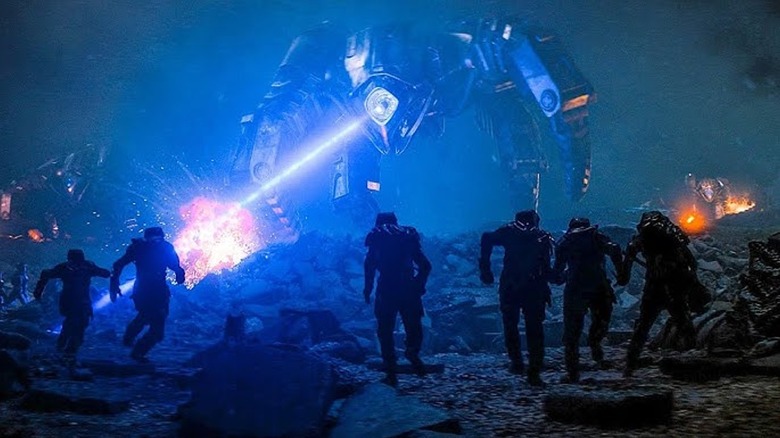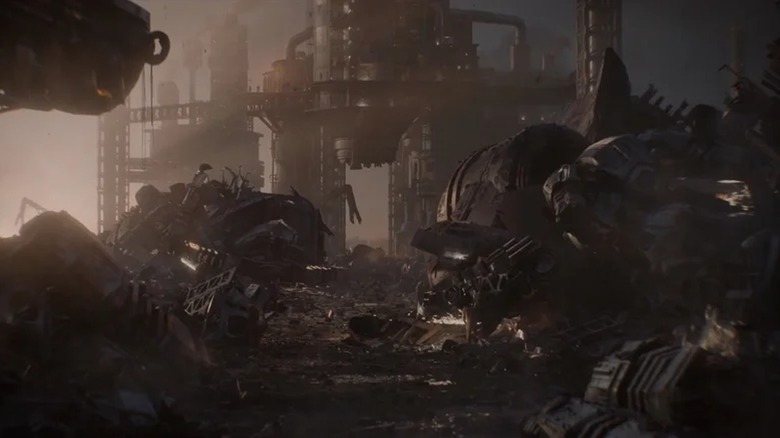This put up accommodates spoilers for Frank Herbert’s “Dune” novel collection.
The rise and fall of Paul Atreides may be the beating coronary heart of the “Dune” saga, however Frank Herbert’s painstakingly wealthy, vibrant worldbuilding eclipses its protagonists. Change is fixed within the “Dune” universe, the place occasions span distant planets and galaxies; the place emperors, messiahs, tyrants, and shadowy forces take turns to form an unsure future. Round 10,000 years earlier than the occasions of “Dune,” a battle was waged towards a technocratic class and their “machines-that-think,” which utterly destroyed (and erased) their legacy and rebuilt society from the bottom up. This extermination marketing campaign that led to computer systems and synthetic intelligence being banned within the Identified Universe perpetually, got here to be generally known as the Butlerian Jihad, or the Great Revolt, which is glimpsed in HBO’s “Dune: Prophecy.”
It’s important to tell apart the outlawed machines in “Dune” from our common understanding of the time period. The time period “considering machine” was used to explain any type of synthetic intelligence with sentience and autonomy, be it within the type of supercomputers or aware robots. The rise of those considering machines was inevitable with the level of technological advancements that blossomed across the Known Universe, however machine intelligence quickly took oppressive kinds that have been detrimental to humanity itself. Humanity’s reply to this pervasive technocracy was spiritual fanaticism (therefore the time period “jihad”) as non secular religion was thought of antithetical to chilly machine logic. Whereas Frank Herbert’s authentic novel collection solely refers back to the Butlerian Jihad in passing, Brian Herbert and Kevin J. Anderson explored it extra deeply in “Dune: The Butlerian Jihad,” which is taken into account part of the collection’ expanded universe.
Let look first Frank Herbert’s exploration of the Nice Revolt after which transfer on to what the expanded universe has to say about this historic occasion set on the planet of “Dune.”
Why humanity rebelled towards the considering machines in Dune
“As soon as males turned their considering over to machines within the hope that this might set them free. However that solely permitted different males with machines to enslave them.”
This quote from “Dune” sums up the catalyst of the Nice Revolt, which insisted on humanity setting their very own pointers to remake the world (one thing machines have been believed to be incapable of, regardless of their sentience). What began as justified discontent shortly spiraled into religion-fueled hysteria, which inspired indiscriminate hatred towards something mechanical in nature. With the whole uprooting of know-how, human civilization underwent a reversal, making a gaping void that wanted to be crammed by one thing utterly reliant on human intelligence.
By 108 B.G. (Earlier than Guild), the mentat order was created to take care of this void. “Mentat” was a self-discipline developed particularly to interchange machine intelligence, and people who displayed the cognitive capability to assume on the identical degree as computer systems have been granted this title. As an example, Thufir Hawat, who loyally served the Atreides centuries later, proved indispensable for his mentat skills, which have been equal to that of a supercomputer. Together with mentats, the all-female Bene Gesserit and the Spacing Guild of Navigators have been established to stop civilization from regressing to a primordial state. However have been these organizations sufficient to fill the gaps left by the machines?
This query was partly answered by the rise of a brand new political system, with the Padishah Emperor from House Corrino acting as the enforcer of a feudal galactic order backed by the Nice Home and key organizations (together with the Bene Gesserit). This method lasted hundreds of years till Paul Atreides topped himself Emperor in 10196 and set one other violent holy battle in movement.
What the expanded Dune universe says in regards to the Nice Revolt
The “Dune” expanded universe, together with elements of “The Dune Encyclopedia” (which features a foreword by Frank Herbert himself), hint the “Butlerian” etymology to Manion Butler the Harmless, whose loss of life was the catalyst for the Nice Revolt. Lengthy story quick, an impartial robotic named Erasmus killed the new child Manion to get his mom Serena’s consideration, throwing the kid from the highest of a tower. Serena, in her rage-fueled despair, destroyed a considering machine guard in retaliation, and the cruelty of this baby homicide instigated an rebellion that ultimately led to the holy battle towards machines. Quickly after, Manion was deemed a non secular martyr, and a spiritual cult was birthed round Serena, additional fueling a newfound obsession with religion and faith.
Serena’s rage grew to become the face of the revolt, garnering the assist of people who have been subjugated by robots like Erasmus up till this level. In retaliation, the considering machines, who have been led by Omnius Prime — the title held by essentially the most influential of AI entities among the many Omnius — unleashed a plague that worn out billions of people. These events took place on a rapidly declining Earth, which was on the cusp of turning into inhabitable because the battle saved raging. As soon as Earth grew to become utterly irradiated because of atomic warfare and pure disasters, the Battle of Corrin (fought on the planet Corrin) emerged because the turning level that helped erase considering machines as soon as and for all.
Though Frank Herbert used temporary mentions of the Nice Revolt to underline the themes of cyclical oppression, the expanded universe helps fill in gaps to attract deeper parallels between the machine battle and the holy battle Paul wages centuries later. Whereas few “Dune” diversifications deal with the machine battle head-on, it’s a narrative strand that’s price revisiting again and again.
This put up accommodates spoilers for Frank Herbert’s “Dune” novel collection.
The rise and fall of Paul Atreides may be the beating coronary heart of the “Dune” saga, however Frank Herbert’s painstakingly wealthy, vibrant worldbuilding eclipses its protagonists. Change is fixed within the “Dune” universe, the place occasions span distant planets and galaxies; the place emperors, messiahs, tyrants, and shadowy forces take turns to form an unsure future. Round 10,000 years earlier than the occasions of “Dune,” a battle was waged towards a technocratic class and their “machines-that-think,” which utterly destroyed (and erased) their legacy and rebuilt society from the bottom up. This extermination marketing campaign that led to computer systems and synthetic intelligence being banned within the Identified Universe perpetually, got here to be generally known as the Butlerian Jihad, or the Great Revolt, which is glimpsed in HBO’s “Dune: Prophecy.”
It’s important to tell apart the outlawed machines in “Dune” from our common understanding of the time period. The time period “considering machine” was used to explain any type of synthetic intelligence with sentience and autonomy, be it within the type of supercomputers or aware robots. The rise of those considering machines was inevitable with the level of technological advancements that blossomed across the Known Universe, however machine intelligence quickly took oppressive kinds that have been detrimental to humanity itself. Humanity’s reply to this pervasive technocracy was spiritual fanaticism (therefore the time period “jihad”) as non secular religion was thought of antithetical to chilly machine logic. Whereas Frank Herbert’s authentic novel collection solely refers back to the Butlerian Jihad in passing, Brian Herbert and Kevin J. Anderson explored it extra deeply in “Dune: The Butlerian Jihad,” which is taken into account part of the collection’ expanded universe.
Let look first Frank Herbert’s exploration of the Nice Revolt after which transfer on to what the expanded universe has to say about this historic occasion set on the planet of “Dune.”
Why humanity rebelled towards the considering machines in Dune
“As soon as males turned their considering over to machines within the hope that this might set them free. However that solely permitted different males with machines to enslave them.”
This quote from “Dune” sums up the catalyst of the Nice Revolt, which insisted on humanity setting their very own pointers to remake the world (one thing machines have been believed to be incapable of, regardless of their sentience). What began as justified discontent shortly spiraled into religion-fueled hysteria, which inspired indiscriminate hatred towards something mechanical in nature. With the whole uprooting of know-how, human civilization underwent a reversal, making a gaping void that wanted to be crammed by one thing utterly reliant on human intelligence.
By 108 B.G. (Earlier than Guild), the mentat order was created to take care of this void. “Mentat” was a self-discipline developed particularly to interchange machine intelligence, and people who displayed the cognitive capability to assume on the identical degree as computer systems have been granted this title. As an example, Thufir Hawat, who loyally served the Atreides centuries later, proved indispensable for his mentat skills, which have been equal to that of a supercomputer. Together with mentats, the all-female Bene Gesserit and the Spacing Guild of Navigators have been established to stop civilization from regressing to a primordial state. However have been these organizations sufficient to fill the gaps left by the machines?
This query was partly answered by the rise of a brand new political system, with the Padishah Emperor from House Corrino acting as the enforcer of a feudal galactic order backed by the Nice Home and key organizations (together with the Bene Gesserit). This method lasted hundreds of years till Paul Atreides topped himself Emperor in 10196 and set one other violent holy battle in movement.
What the expanded Dune universe says in regards to the Nice Revolt
The “Dune” expanded universe, together with elements of “The Dune Encyclopedia” (which features a foreword by Frank Herbert himself), hint the “Butlerian” etymology to Manion Butler the Harmless, whose loss of life was the catalyst for the Nice Revolt. Lengthy story quick, an impartial robotic named Erasmus killed the new child Manion to get his mom Serena’s consideration, throwing the kid from the highest of a tower. Serena, in her rage-fueled despair, destroyed a considering machine guard in retaliation, and the cruelty of this baby homicide instigated an rebellion that ultimately led to the holy battle towards machines. Quickly after, Manion was deemed a non secular martyr, and a spiritual cult was birthed round Serena, additional fueling a newfound obsession with religion and faith.
Serena’s rage grew to become the face of the revolt, garnering the assist of people who have been subjugated by robots like Erasmus up till this level. In retaliation, the considering machines, who have been led by Omnius Prime — the title held by essentially the most influential of AI entities among the many Omnius — unleashed a plague that worn out billions of people. These events took place on a rapidly declining Earth, which was on the cusp of turning into inhabitable because the battle saved raging. As soon as Earth grew to become utterly irradiated because of atomic warfare and pure disasters, the Battle of Corrin (fought on the planet Corrin) emerged because the turning level that helped erase considering machines as soon as and for all.
Though Frank Herbert used temporary mentions of the Nice Revolt to underline the themes of cyclical oppression, the expanded universe helps fill in gaps to attract deeper parallels between the machine battle and the holy battle Paul wages centuries later. Whereas few “Dune” diversifications deal with the machine battle head-on, it’s a narrative strand that’s price revisiting again and again.






















